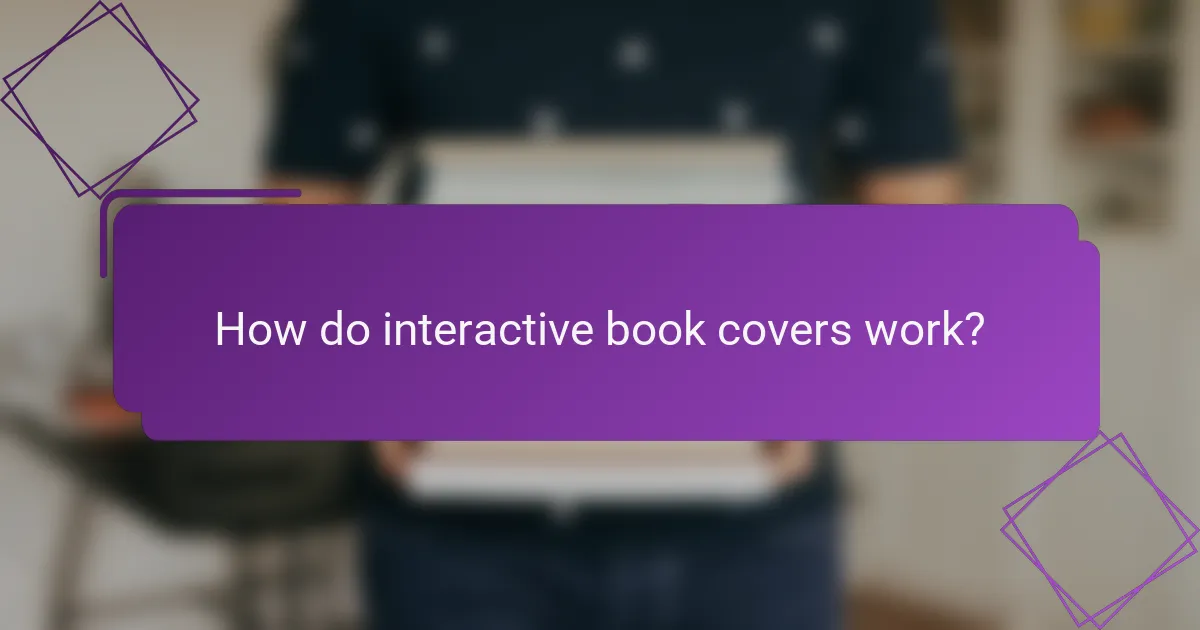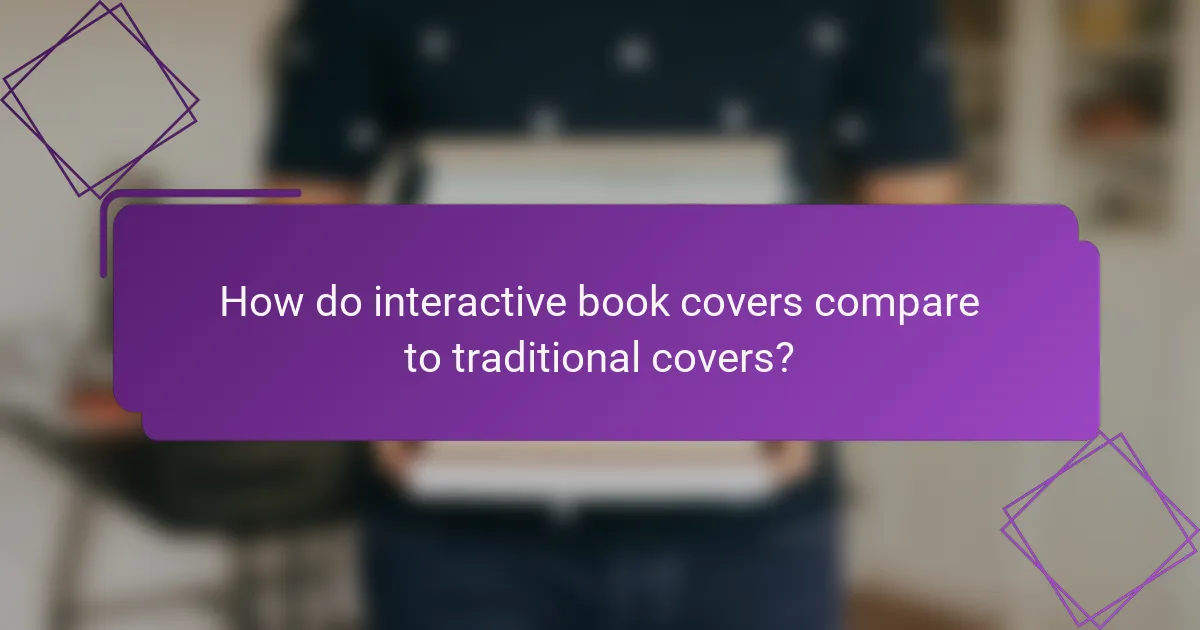Interactive book covers revolutionize the reading experience by integrating digital technology to engage audiences through animations, sound, and clickable features. These dynamic designs not only enhance reader engagement but also boost sales potential and brand visibility, making books more appealing and memorable. However, it’s essential to consider the associated costs of design, development, and hosting to ensure a successful project.

What are the benefits of interactive book covers?
Interactive book covers offer numerous advantages, including enhanced reader engagement, increased sales potential, and improved brand visibility. These dynamic designs can captivate audiences and create a memorable reading experience.
Enhanced reader engagement
Interactive book covers engage readers by providing an immersive experience that traditional covers cannot match. Features such as animations, sound effects, or augmented reality elements can draw readers in and encourage them to explore the content further.
Consider incorporating elements that allow readers to interact directly with the cover, such as touch-responsive features or QR codes linking to exclusive content. This not only piques interest but also fosters a deeper connection with the material.
Increased sales potential
Books with interactive covers often see a boost in sales due to their eye-catching nature and unique presentation. By standing out on shelves or online platforms, these covers can attract more attention from potential buyers.
When designing an interactive cover, consider your target audience and their preferences. A well-executed interactive element can lead to higher conversion rates, especially in competitive markets where differentiation is key.
Improved brand visibility
Interactive book covers can significantly enhance brand visibility by creating a memorable first impression. When readers share their experiences online, whether through social media or word-of-mouth, it amplifies the reach of your brand.
To maximize brand visibility, ensure that the interactive elements are aligned with your overall branding strategy. Consistent use of colors, logos, and themes can help reinforce brand identity while making the book more recognizable in a crowded marketplace.

How do interactive book covers work?
Interactive book covers utilize digital technology to engage readers through dynamic elements such as animations, sound, and clickable features. These covers enhance the reading experience by providing additional content and interactivity, making the book more appealing and memorable.
Digital integration techniques
Digital integration techniques for interactive book covers often involve the use of augmented reality (AR) and QR codes. These methods allow readers to scan the cover with their smartphones, revealing hidden content like videos, author interviews, or interactive illustrations.
Another common technique is the use of embedded multimedia elements, such as animations or sound effects, which can be triggered by user interactions. This approach not only captivates the audience but also helps convey the book’s themes in a more engaging manner.
User interaction features
User interaction features are essential for creating an immersive experience. Features such as touch-responsive elements or swipeable content can encourage readers to explore the cover more thoroughly. For instance, a reader might swipe to reveal character profiles or plot summaries.
Additionally, gamification elements, like quizzes or challenges related to the book’s content, can enhance engagement. These features not only entertain but also deepen the reader’s connection to the material, making them more likely to purchase or recommend the book.

What are the costs associated with creating interactive book covers?
Creating interactive book covers involves various costs, including design, development, and hosting fees. Understanding these expenses is crucial for budgeting and ensuring a successful project.
Design and development expenses
Design and development costs for interactive book covers can vary significantly based on complexity and features. Simple designs may start in the low hundreds of USD, while more intricate projects can reach thousands. It’s essential to consider the skill level of the designers and developers, as experienced professionals typically charge higher rates.
When planning your budget, factor in the time required for revisions and testing. A well-defined project scope can help minimize unexpected costs. Collaborating with a team familiar with interactive elements can also enhance the final product’s quality.
Platform fees for hosting
Hosting fees for interactive book covers depend on the platform chosen and the expected traffic. Basic hosting services can range from $5 to $30 per month, while more robust solutions may cost $100 or more monthly. Consider factors like storage, bandwidth, and support when selecting a hosting provider.
Some platforms may charge additional fees for specific features or higher traffic volumes. It’s advisable to review the terms and conditions carefully to avoid surprises. Additionally, consider using platforms that offer scalability to accommodate future growth without incurring excessive costs.

Which tools are best for designing interactive book covers?
Several tools stand out for designing interactive book covers, each offering unique features and capabilities. Adobe InDesign, Canva, and BookWright are popular choices that cater to different skill levels and design needs.
Adobe InDesign
Adobe InDesign is a professional-grade tool widely used in the publishing industry for creating interactive book covers. It allows for advanced design options, including animations, hyperlinks, and multimedia integration, making it ideal for complex projects.
When using InDesign, consider its steep learning curve, which may require some training or experience. However, the investment pays off for high-quality, polished designs. Ensure you are familiar with the software’s interactive features to maximize its potential.
Canva
Canva is a user-friendly design platform that simplifies the creation of interactive book covers, making it accessible for beginners. It offers a variety of templates and drag-and-drop functionality, allowing users to easily incorporate interactive elements like links and videos.
While Canva is less powerful than InDesign for complex designs, it is perfect for quick projects or those on a budget. Take advantage of its extensive library of images and graphics, but be mindful of licensing terms for commercial use.
BookWright
BookWright is a free tool from Blurb specifically designed for book creation, including interactive covers. It provides templates and a straightforward interface, making it easy to design and publish both print and digital books.
One advantage of BookWright is its seamless integration with Blurb’s printing services, which simplifies the process of turning your design into a physical book. However, its features may be limited compared to more advanced software, so assess your needs before choosing this option.

How do interactive book covers compare to traditional covers?
Interactive book covers offer a dynamic experience that engages readers differently than traditional covers. While traditional covers rely on static images and text, interactive covers incorporate multimedia elements, enhancing user engagement and potentially increasing sales.
Engagement metrics
Engagement metrics for interactive book covers often surpass those of traditional covers. Readers are more likely to interact with features such as animations, audio, or embedded videos, leading to longer time spent on the cover page. This increased interaction can translate to higher conversion rates, as users feel a deeper connection to the content.
For example, a study might show that interactive covers can increase click-through rates by 20-30% compared to static designs. Tracking metrics like user interactions, time spent, and social shares can help gauge effectiveness.
Cost-effectiveness
While the initial investment in creating interactive book covers may be higher than traditional designs, they can prove cost-effective in the long run. The ability to engage users more effectively can lead to increased sales, offsetting the upfront costs associated with development.
Consider budgeting for interactive features, which can range from a few hundred to several thousand USD, depending on complexity. Weigh these costs against potential revenue increases from higher engagement and sales, ensuring a balanced approach to your marketing strategy.

What are the trends in interactive book cover design?
Interactive book cover design is increasingly incorporating technology to enhance reader engagement and personalization. Key trends include augmented reality features and various personalization options that cater to individual preferences.
Augmented reality features
Augmented reality (AR) features in book covers allow readers to interact with the content through their smartphones or tablets. This technology can bring illustrations to life, provide additional information, or even create immersive experiences related to the book’s theme.
When considering AR for book covers, it’s essential to ensure that the technology is user-friendly and enhances the reading experience rather than complicating it. For example, a simple scan of the cover could reveal a video trailer or an animated character from the story.
Personalization options
Personalization options in interactive book covers enable readers to customize their experience based on their preferences. This can include selecting different cover designs, colors, or even interactive elements that change based on reader choices.
Offering personalization can significantly increase engagement, as readers feel a stronger connection to a book that reflects their tastes. Publishers should consider implementing features like customizable text or images, allowing readers to create a unique version of the cover that resonates with them.

